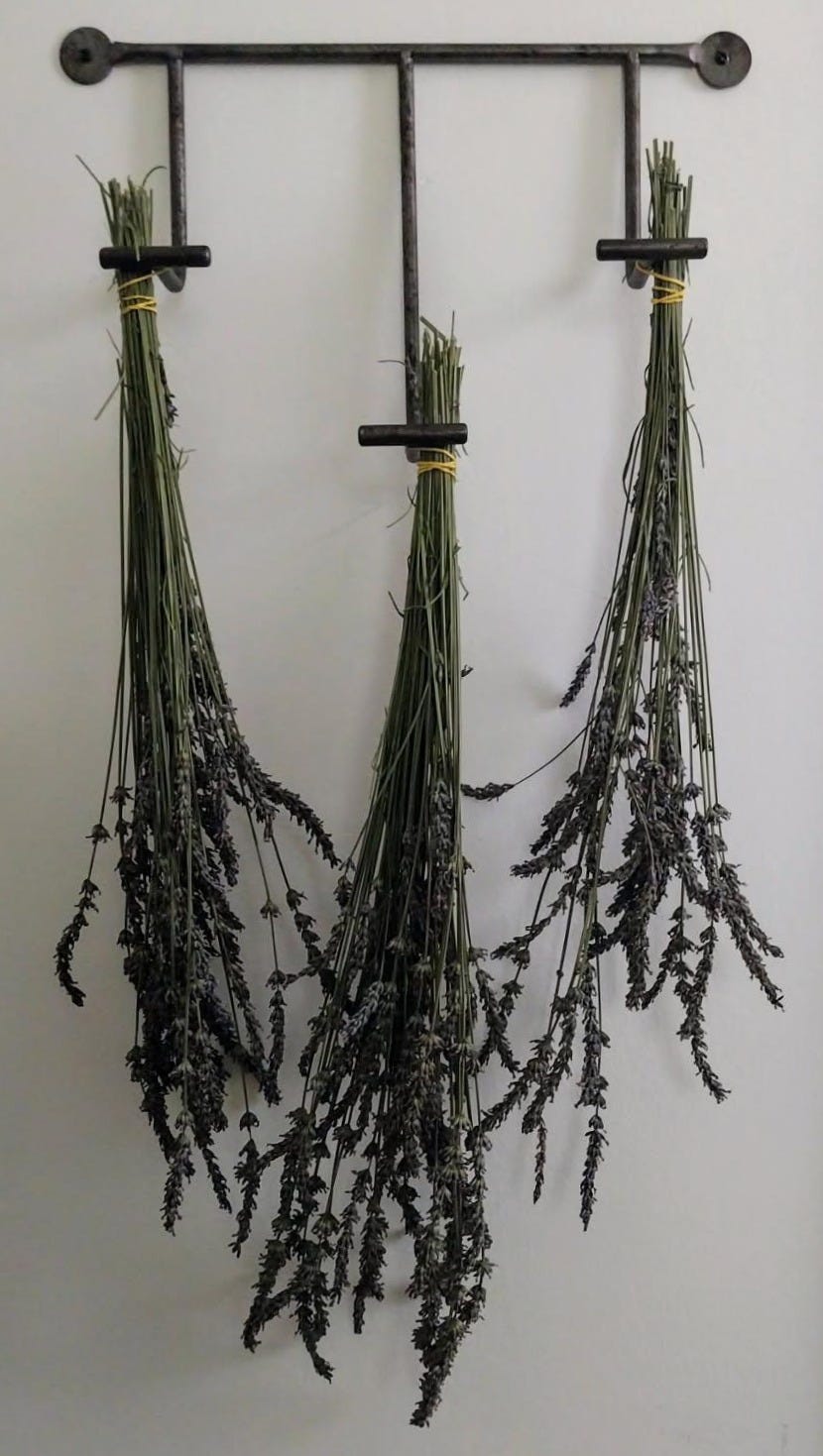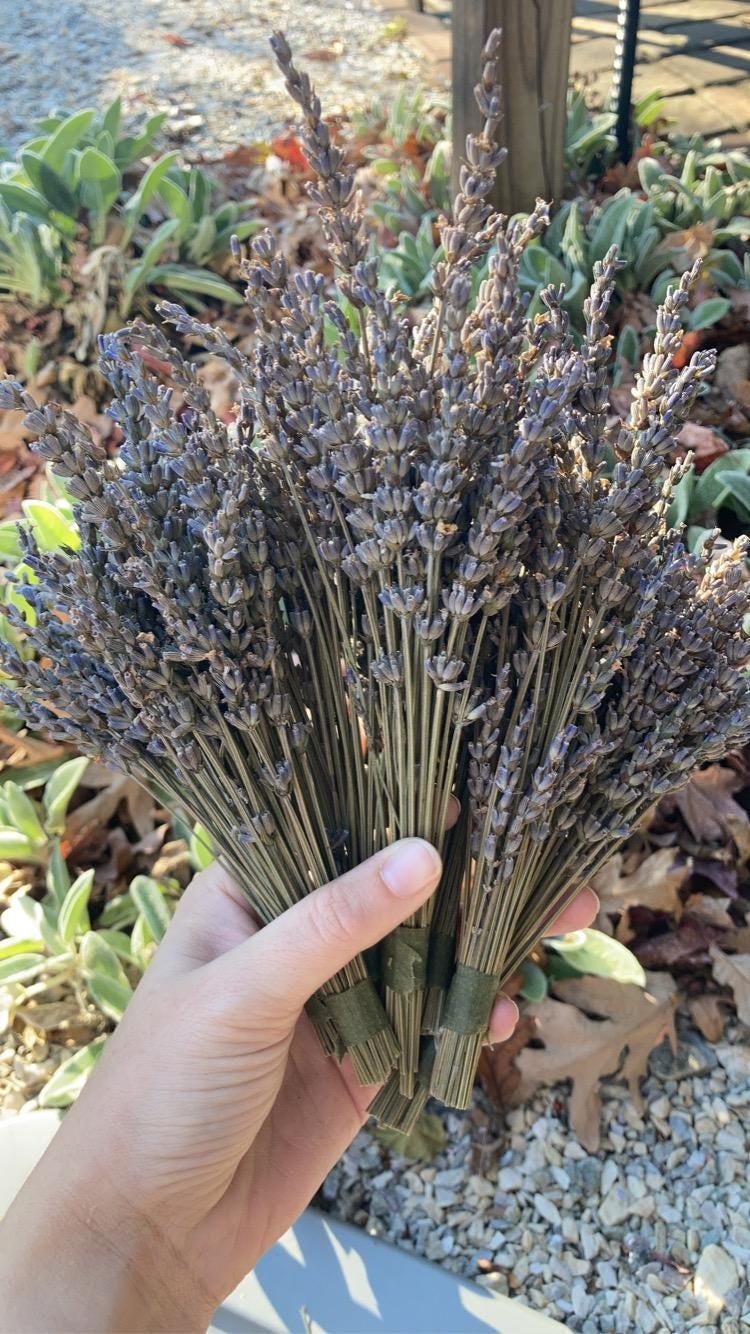Lavandula angustifolia
(also known as English lavender, true lavender, or simply: lavender)
Each time I see it bloom; those soft violet spires rising from silvered stems, humming with bees in the thick of summer—lavender stops me. Not for its novelty, but for its familiarity. Its gentleness. Its quiet strength. The strong smell of it assaults my nose in the kindest of ways.
Lavender does not shout for attention.
It offers it.
Not only a scent, but a presence.
Not only an herb, but a memory.
Six summers ago, when my July wedding arrived, the lavender my mother had tended for years was already in full bloom. A sea of purple, swaying like a field of fragrant prayers. I didn’t need to spend a small fortune on flowers, not that I had any fortune to spend. Mom simply sheathed down armfuls of her lavender and gifted them to me. She offered her garden freely as blessing.
We bundled it into bouquets for each bridesmaid, sticking fresh sprigs into my own flowers. Lavender was set on each table as scentful centerpiece. We wove it into welcome and let it perfume everything with the clean, warm scent of summer and devotion.
I think about that often: how lavender showed up at my wedding not just as a flower, but as a testimony. Of labor. Of love. Of transition.
Later, to mark that moment—of the leaving and the cleaving, of honoring where I came from while stepping into something new—I got a lavender tattoo. (We can debate tattoos later) It remains my favorite.
It reminds me of who raised me.
And it tells me why I now build a home of my own.
Lavender, after all, is an herb of care. Of keeping. Of comfort and covenant.
It is a plant that carries presence wherever it goes.
of Sunlit Slopes
Native to the Mediterranean basin, Lavandula angustifolia has long grown in dry, rocky soils along coastal hills and wind-swept plateaus. There, the Romans once bathed with it. The Greeks burned it in sacred rites. The Persians steeped it in vinegars and oils. And long before colonial trade named it “English,” lavender had already belonged to the lands beyond.
Traditional Mediterranean herbalists used it for ailments of the nerves and lungs, for grief and fatigue, for restless children and hearts too burdened to sleep. Among Berber women in North Africa, lavender was sometimes woven into bridal garments or buried with the dead—fragrance as prayer, scented remembrance. It soothed the living and honored the departed.
The very name comes from the Latin lavare—to wash. (I remember my Latin teacher helping me to recall this word as it “sounds like an expensive soap”, he’d said.) But lavender does more than cleanse.
It calms.
It clarifies.
It lingers.
In medieval Europe, lavender was hung above doorways to keep illness or evil spirits at bay. Tucked into linen chests, its scent deterred moths—and maybe chased away small melancholies too. Bundles were burned in sickrooms during plagues, and carried into battlefields by nurses during war.
Some of those uses are now backed by modern science. Some are not. Still lavender persists. Lingers, as it will.
Lavender and the Body
Among herbalists today, Lavandula angustifolia is a trusted ally.
Its essential oil, widely studied, shows promise for reducing nervous tension, supporting restful sleep, and easing occasional headaches or stress responses. It is one of the few oils considered gentle enough for direct skin application (though always best diluted), and has been used in compresses, bath blends, teas, and diffusions alike.
Herbal preparations of lavender (especially tisane infusions or teas) are known to be:
• Gently calming to the nervous system
• Supportive of sleep onset and quality
• Soothing to digestion when upset is stress-related
• Mildly uplifting to mood
• Antimicrobial and anti-inflammatory topically (in oils or salves)
Lavender can also be found in some traditional smoke blends—often paired with herbs like mullein, rose, or damiana. While not a mainstream practice, this gentle aromatic smoke has historically been used by some for calming the nerves or gentle respiratory support (gentle but serious disclaimer that smoking anything, even soothing lavender, can be harmful to your lungs. Research and understand the risks of smoking before partaking if you so choose to do so). Inhalation through smoke is not without risk and may not be suitable for all bodies—but for some, this form of lavender evokes a settling clarity, a space-making breath. Herbs can also be burned in place of an aromatic incense, or used in a simmer pot over the stove if you wish to release steam or smoke without inhaling it directly.
(As always, consult with trusted sources and pay attention to your own body before use. Smoking any plant carries potential risks and is not advised for those with asthma, pre-existing lung conditions, or sensitivities.)
And while research is still ongoing, some practitioners and community herbalists use lavender blends to support focus in neurodivergent folks—especially those with sensory sensitivity, anxious restlessness, or attention challenges. This would be those flying fish I’ve afore mentioned.
I make a personal tea blend at home (affectionately called ADHTea) with lavender and some others that are helpful for mental focus and honing the flying fish thoughts into some semblance of a net. Like calming the brain around its edges. It doesn’t "treat" anything—and I won’t claim that it does—but it offers something I welcome: a breath. A pause. A gentler state of attention. That alone can be enough for the rest of me to catch up and rest for a moment.
Try: Steeping a cup of lavender (or lavender blend) tea and also use some in a warm bath. Enjoy together for the steam inside and outside soothing your skin and mind alike.
Herbalism, after all, is not about replacing all the research and methods of modern medicine. It’s about restoring a forgotten relationship—to plants, to design, to one’s own body. And lavender is a plant that reminds me to return. To breathe. To soften.
Lavender was made to soothe.
Not to numb. Not to erase or blot out like many over-the-counter pharmaceuticals do.
But to soften what’s been hardened by noise and demand and the low-grade ache of living in a fallen world.
Lavender is gentle. But not weak. Its calming isn’t escapism. It’s invitation.
To breathe slower.
To return to presence.
To remember that peace is not the absence of thought, but the ordering of it under a yoke that is easy and a burden that is light.
“Come to me, all who are weary and burdened, and I will give you rest.”
—Matthew 11:28
I keep lavender on hand in several forms:
• Dried, for tea and sachets
• Infused oil, for skin or salves (lavender & calendula make a great salve for minor wounds)
• Essential oil, for diffusion or baths (if you have pets, most essential oils should not be used frequently, especially around cats.)
• Tincture, rarely, in small doses before bed
Not everything needs to be solved.
Some things simply need to be tended.
How to Use Lavender (Safely)
• Tea or infusion – gently calming; pairs well with lemon balm or mint
• Essential oil – a few drops in bath/diffuser or diluted in a safe oil for massage
• Salve or balm – soothing to skin irritations, minor burns, or tension points
• Sachets or sleep pillows – tucked in linens to support rest
• Smoke blend (traditional) – in small amounts, paired with other herbs; use with discretion and awareness.
Note: Lavender is generally safe for most people when used appropriately. As always, consult a trusted healthcare practitioner if you are pregnant, nursing, managing chronic conditions, or taking medications. Essential oils should never be ingested.
NOTE: essential oils and infused oils are not the same thing.
Lavender reminds me that peace, while quiet sometimes, is not passive.
It is actively cultivated. Tended to. Brought forth with purpose.
And sometimes, peace smells like a garden warmed by the sun, full of bees and memory, held in the quiet purple bloom of a plant made to bless.
Lavender was made to soothe—not as escape, but as restoration.
A field between stillness and song.
In the cultivating,
—Flourish & Fray
Writer’s Note: If you got to the end of this HERBARIUM post and enjoyed it, please say so in the comments below. I would genuinely love to hear from you.
Thank you for hanging out here in the Garden with me. If this is your first time sitting amongst the moss with us, you are invited to join us again and again
If something here from Flourish & Fray resonates with you, you can share it with others and I would be grateful that you think my work worth sharing
May the peace of lavender settle your thoughts like bees in bloom. May the scent of memory and covenant follow you wherever your feet carry you today.







Sometimes lavender tstes like soap! Why? Because there is the Culinary type (what you discussed in your article) and then there's the Non-Culinary Lavender.
Not all lavender is suitable for cooking. The culinary variety, known as lavandula angustifolia (English lavender as in your article), has a sweeter, milder flavor. In contrast, other types, like lavandula stoechas, can have more pungent and bitter notes, which may contribute to the soapy taste. I personally grow Lavender Phenomenon with is a considered a cross, non edible, called "x intermediate". Great for sachets but not in tea. The English lavender is great for everything but is more finicky to grow. Just sayin....
Gotu Kola. Because…